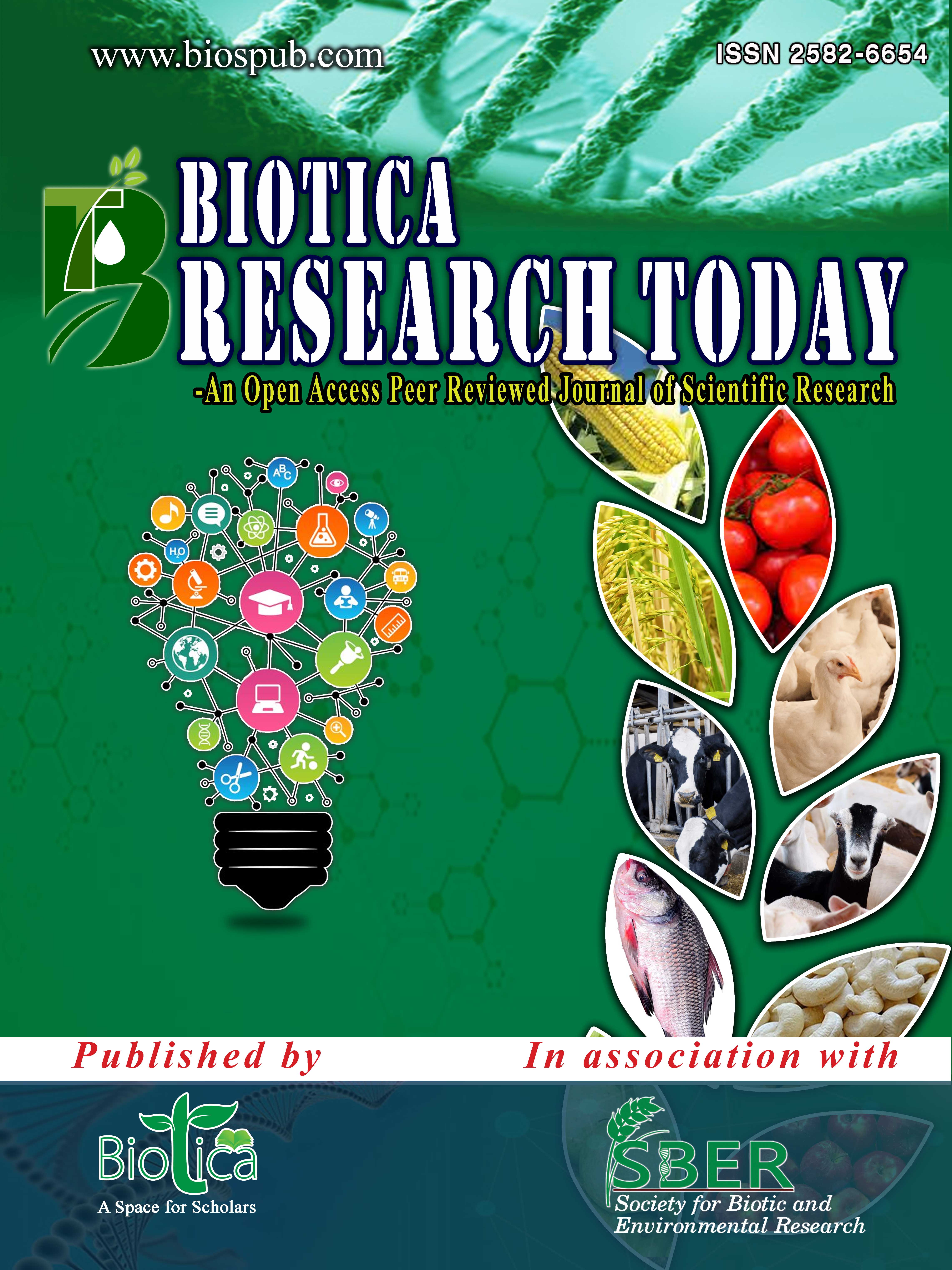Biopriming of Tomato Seeds with Native Trichoderma Species for Enhanced Seedlings Vigour
DOI:
https://doi.org/10.54083/ResBio/5.3.2023/113-116Keywords:
Biopriming, Seedling vigour, Solanum lycopersicum L., Tomato, Trichoderma species, Vegetable cropAbstract
The present research was carried out to investigate the effect of tomato seed biopriming using six native Trichoderma isolates under laboratory conditions. The seeds of tomato were primed in Trichoderma isolates and as a control treatment seeds were treated in sterile distilled water. It was observed that all the six native Trichoderma isolates showed good performance with respect to growth, germination percentage and vigour index of tomato seedlings as compared to control. Among the different Trichoderma isolates tested, T5 isolate showed highest shoot growth (5.44 cm), root growth (3.74 cm), germination percentage (90.0%) and seedling vigour index (826.37) followed by T4 isolate. The lowest shoot growth (4.22 cm), root growth (3.07 cm), germination percentage (56.7%) and seedling vigour index (412.70) were recorded in untreated control.
Downloads
References
Abdul-Baki, A.A., Anderson, J.D., 1973. Vigor determination in soybean seed multiple criteria. Crop Science 13(6), 630-633. DOI: https://doi.org/10.2135/cropsci1973.0011183X001300060013x. DOI: https://doi.org/10.2135/cropsci1973.0011183X001300060013x
Anonymous, 2022. Agricultural Statistics at a Glance 2022. Government of India, Ministry of Agriculture & Farmers Welfare, Department of Agriculture & Farmers Welfare, Economics & Statistics Division, New Delhi (110 001), India. URL: www.agricoop.nic.in, https://desagri.gov.in.
Bennett, M.A., Fritz, V.A., Callan, N.W., 1992. Impact of seed treatments on crop stand establishment. HortTechnology 2(3), 345-349. DOI: https://doi.org/10.21273/HORTTECH.2.3.345. DOI: https://doi.org/10.21273/HORTTECH.2.3.345
Bhagat, S., Bambawale, O.M., Tripathi, A.K., Ahmad, I., Srivastava, R.C., 2013. Biological management of fusarial wilt of tomato by Trichoderma spp. in Andamans. Indian Journal of Horticulture 70(3), 397-403.
Callan, N.W., Mathre, D.E., Miller, J.B., Vavrina, C.S., 1997. Biological seed treatments: factors involved in efficacy. Horticultural Science 32(2), 179-183. DOI: https://doi.org/10.21273/HORTSCI.32.2.179
Elad, Y., Chet, I., Henis, Y., 1981. A selective medium for improving quantitative isolation of Trichoderma spp. from soil. Phytoparasitica 9, 59-67. DOI: https://doi.org/10.1007/BF03158330. DOI: https://doi.org/10.1007/BF03158330
Harman, G.E., 2000. Myths and dogmas of biocontrol: Changes in perceptions derived from research on Trichoderma harzianum T-22. Plant Disease 84(4), 377-393. DOI: https://doi.org/10.1094/PDIS.2000.84.4.377. DOI: https://doi.org/10.1094/PDIS.2000.84.4.377
Harman, G.E., Taylor, A.G., 1988. Improved seedling performance by integration of biological control agents at favorable pH levels with solid matrix priming. Phytopathology 78(5), 520-525. DOI: https://doi.org/10.1094/Phyto-78-520. DOI: https://doi.org/10.1094/Phyto-78-520
Jensen, B., Knudsen, I.M.B., Madsen, M., Jensen, D.F., 2004. Biopriming of infected carrot seed with an antagonist, Clonostachys rosea, selected for control of seed borne Alternaria spp. Phytopathology 94(6), 551-560. DOI: https://doi.org/10.1094/PHYTO.2004.94.6.551. DOI: https://doi.org/10.1094/PHYTO.2004.94.6.551
Kthiri, Z., Jabeur, M.B., Omri, N., Hamada, W., 2020. Effect of coating seeds with Trichoderma harzianum (S. INAT) on the oxidative stress induced by Fusarium culmorum in durum wheat. Journal of New Sciences: Agriculture and Biotechnology 77(5), 4150-4522.
Nezarat, S., Gholami, A., 2009. Screening plant growth promoting rhizobacteria for improving seed germination, seedling growth and yield of maize. Pakistan Journal of Biological Sciences 12(1), 26-32. DOI: https://doi.org/10.3923/pjbs.2009.26.32. DOI: https://doi.org/10.3923/pjbs.2009.26.32
Pill, W.G., Collins, C.M., Goldberger, B., Gregory, N., 2009. Responses of non-primed or primed seeds of ‘Marketmore 76’ cucumber (Cucumis sativus L.) slurry coated with Trichoderma species to planting in growth media infested with Pythium aphanidermatum. Scientia Horticulturae 121(1), 54-62. DOI: https://doi.org/10.1016/j.scienta.2009.01.004. DOI: https://doi.org/10.1016/j.scienta.2009.01.004
Raju, N.S., Niranjana, S.R., Janardhana, G.R., Prakash, H.S., Shetty, H.S., Mathur, S.B., 1999. Improvement of seed quality and field emergence of Fusarium moniliforme infected sorghum seeds using biological agents. Journal of the Science of Food and Agriculture 79(2), 206-212. DOI: https://doi.org/10.1002/(SICI)1097-0010(199902)79:2<206::AID-JSFA167>3.0.CO;2-Y. DOI: https://doi.org/10.1002/(SICI)1097-0010(199902)79:2<206::AID-JSFA167>3.0.CO;2-Y
Saha, D.K., Pan, S., 1997. Qualitative evaluation of some specific media of Trichoderma and Gliocladium spp. Journal of Mycopathological Research 35, 7-13.
Saxena, A., Raghuwanshi, R., Singh, H.B., 2015. Trichoderma species mediated differential tolerance against biotic stress of phytopathogens in Cicer arietinum L. Journal of Basic Microbiology 55(2), 195-206. DOI: https://doi.org/10.1002/jobm.201400317. DOI: https://doi.org/10.1002/jobm.201400317
Sehim, A.E, Hewedy, O.A., Altammar, K.A., Alhumaidi, M.S., Abd Elghaffar, R.Y., 2023. Trichoderma asperellum empowers tomato plants and suppresses Fusarium oxysporum through priming responses. Frontiers in Microbiology 14, 1140378. DOI: https://doi.org/10.3389/fmicb.2023.1140378. DOI: https://doi.org/10.3389/fmicb.2023.1140378
Sharma, A., Shukla, A., Gupta, M., 2023. Effect of bioagents on cucumber seed mycoflora, seed germination, and seedling vigour. Scientific Reports 13, 6052. DOI: https://doi.org/10.1038/s41598-023-30253-3. DOI: https://doi.org/10.1038/s41598-023-30253-3
Woo, S.L., Ruocco, M., Vinale, F., Nigro, M., Marra, R., Lombardi, N., Pascale, A., Lanzuise, S., Manganiello, G., Lorito, M., 2014. Trichoderma-based products and their widespread use in agriculture. The Open Mycology Journal 8, 71-126. DOI: https://doi.org/10.2174/1874437001408010071. DOI: https://doi.org/10.2174/1874437001408010071
Yadav, S.K., Dave, A., Sarkar, A., Singh, H.B., Sharma, B.K., 2013. Co-inoculated biopriming with Trichoderma, Pseudomonas and Rhizobium improves crop growth in Cicer arietinum and Phaseolus vulgaris. International Journal of Agriculture, Environment and Biotechnology 6(2), 255-259.
Downloads
Published
How to Cite
Issue
Section
License
Copyright (c) 2023 Research Biotica

This work is licensed under a Creative Commons Attribution-NonCommercial-NoDerivatives 4.0 International License.
Submission of a manuscript implies that when the manuscript is accepted for publication, the authors agree to automatic transfer of the copyright to the publisher (or grant the Publisher exclusive publication and dissemination rights). The Biotica, as the publisher, has the right to enter into any agreement with any organization in India or abroad engaged in reprography, photocopying, storage and dissemination of information contained in this journal. The Biotica has no objection in using the material, provided the information is being utilized for academic purpose but not for commercial use. Due credit line should be given to Biotica where information will be utilized.









 |
|


